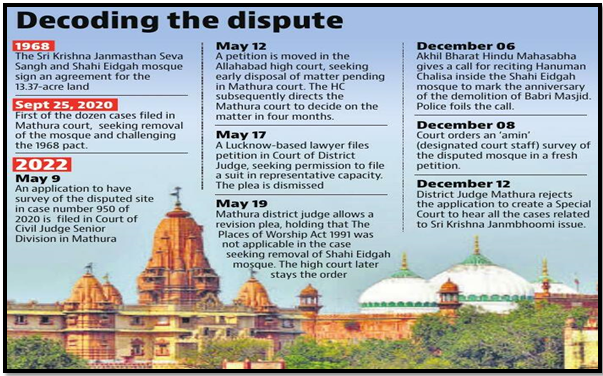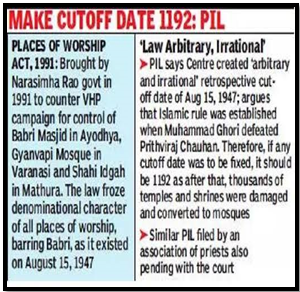EXAMINING MOTIVATED LITIGATION
Syllabus :
- GS 1 : Communalism and Secularism
- GS 2 : Judgement and Cases
Why in the News?
- The Supreme Court has temporarily halted the execution of an Allahabad High Court order appointing a commissioner to inspect the Shahi Idgah Mosque in Mathura.
- The top court raises concerns over the vague grounds presented for the appointment, emphasizing the need for specific reasons.
What were Supreme Court’s View ?
- Referring to a recent precedent, the Supreme Court asserts that civil courts should refrain from granting interim relief if there are questions about the suit’s maintainability or if it is legally barred.
- The court emphasizes the importance of clarity regarding the grounds and legal basis for initiating such cases.
History of the Mathura Dispute
- Raja Veer Singh Bundela erected a temple in Orchha in 1618, later replaced by Aurangzeb’s mosque in 1670.
- The Mathura Krishna Janmasthan temple, dating back 2,000 years, faces a survey due to demands for full ownership post-Aurangzeb’s 1670 destruction.
- The disputed land, initially nazul under Marathas and then the British, saw the temple built in 1618 during Jahangir’s rule.
- In 1815, the Raja of Benaras acquired the land, leading to the establishment of the Shri Krishna Janmabhoomi Trust in 1951.
- A 1968 agreement ceded land to the Shahi Idgah Masjid Trust, sparking the current dispute over complete land possession.
- Hindu worshippers claim that the Shahi Idgah Mosque, located next to a Krishna temple, stands on the birthplace of Lord Krishna.
- The committee managing the Shahi Idgah Mosque challenges the suit filed in the name of the deity, Bhagwan Sri Krishna Virajman, citing the Places of Worship (Special Provisions) Act, 1991.
- Multiple suits related to the mosque are pending, transferred to the Allahabad High Court for disposal.
- The committee questions the suit’s maintainability based on the legal constraints of the Places of Worship Act.
Current Status :
- The Mathura dispute was previously settled through a compromise in 1968 between the Sri Krishna Janmasthan Seva Sansthan and the Shahi Idgah Trust, implemented through a 1973 decree.
- Current suits challenge this compromise as ‘fraudulent,’ seeking the transfer of the entire land to the deity.
- The appointment of a commissioner is viewed as an attempt to find evidence supporting Hindu claims.
Understanding Places of Worship (Special Provisions) Act, 1991
- Enactment and Objective:
Source: Magzter
- Instituted to preserve the status of religious places as of August 15, 1947.
- Prohibits conversion and safeguards the original religious character of places of worship.
- Prevents fresh suits aiming to alter the status of a place of worship.
- Key Provisions:
- Prohibition of Conversion (Section 3): Restricts the conversion of places of worship between denominations or within the same denomination.
- Maintenance of Religious Character (Section 4(1): Mandates the preservation of a place of worship’s religious identity as of August 15, 1947.
- Abatement of Pending Cases (Section 4(2): Terminates ongoing legal proceedings related to pre-1947 conversion cases and bars initiation of new cases.
- Exceptions (Section 5):
- Does not apply to ancient monuments covered by the Ancient Monuments Act.
- Excludes settled cases, disputes resolved by mutual agreement, and conversions predating the Act.
- Specifically excludes the Ram Janmabhoomi-Babri Masjid site in Ayodhya and associated legal proceedings.
- Penalties (Section 6): Prescribes penalties, including a maximum three-year imprisonment term and fines, for violating the Act.
Source: ToI
Criticism of Places of Worship Act:
Bar on Judicial Review:
- Critics assert that the Act hinders judicial review, compromising a fundamental aspect of the Constitution.
- This limitation is seen as undermining the checks and balances system, restricting the judiciary’s role in safeguarding constitutional rights.
Arbitrary Retrospective Cutoff Date:
- The Act faces criticism for using an arbitrary date (Independence Day, 1947) to determine religious places’ status.
- Opponents argue that this cutoff disregards historical injustices and denies redressal for encroachments before the specified date.
Violation of the Right to Religion:
- Critics claim the Act infringes upon the religious rights of Hindus, Jains, Buddhists, and Sikhs.
- It is argued to restrict their ability to reclaim and restore places of worship, impacting their freedom to practice religion.
Violation of Secularism:
- Opponents contend that the Act breaches the principle of secularism, favoring one community over others.
- This is seen as undermining the equal treatment of religions, a core component of the Constitution.
Exclusion of Ayodhya Dispute:
- Specific criticism targets the Act’s exclusion of the Ayodhya dispute, raising questions about consistency in treatment of religious sites.
- Concerns are voiced over the differential approach to various contested locations.
Supreme Court’s Stance on the Act:
- The Supreme Court views the Places of Worship Act as a legislative intervention upholding the commitment to secularism.
- It enforces the constitutional obligation to ensure equality among religions, guaranteeing the preservation of places of worship for all communities.
Judicial Caution against Motivated Litigation
- Expressing concern, the article highlights a recurring pattern of using the judiciary to attack Muslim places of worship by alleging their construction on Hindu structures.
- Courts are urged to exercise caution and swiftly determine the maintainability of such suits, particularly in light of statutory bars like the 1991 Act.
Way Forward:
- Undertake a comprehensive review of the Act to address criticisms and rectify shortcomings.
- Ensure the Act does not impede judicial review, preserving the judiciary’s role in protecting constitutional rights.
- Strike a balance between preserving religious character and respecting diverse communities’ rights.
- Engage in public consultation, enhance transparency, and review the exclusion of specific sites for fairness and consistency.
In navigating the complex intersection of religious sentiments and legal frameworks, it is crucial for the judiciary to critically assess the motivations behind litigations targeting places of worship and uphold the principles outlined in relevant legislation.
Source:
Mains Practice Question:
Critically analyze the phenomenon of motivated litigation in India, examining its impact on the judicial system and governance.

 Source: Magzter
Source: Magzter Source: ToI
Source: ToI

